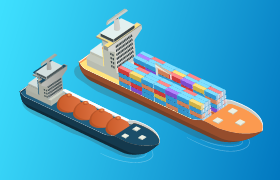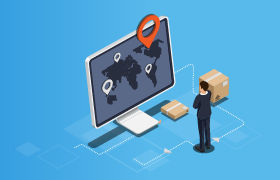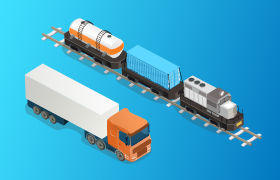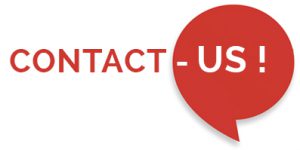SAFE via conex™ is the solution developed by CONEX to manage advance security declarations that must be lodged prior to the importation of goods into certain customs territories and countries. Our solution complies with the World Customs Organisation’s SAFE Framework of Standards. SAFE via conex™ respects the regulations of each country as well as the various communication protocols with the relevant customs administration servers.
With SAFE via conex™, you benefit from an intuitive and reliable work interface, completely freed from the technical constraints associated with the transmission of security messages. In the context of the new British customs formalities brought about by the United Kingdom's exit from the European Union, SAFE via conex™ provides a connection to the GVMS (Goods Vehicle Movement Service) and S&S GB (Safety & Security) system.

IMPORT CONTROL SYSTEM
ICS: advance security declaration for goods entering the EU customs territory.

PNTS
(ANTES) FR
Managing the formalities related to the presentation of goods and temporary storage.

S&S GB
SAFETY & SECURITY
S&S GB: security declaration for goods entering Great Britain’s customs territory

GOODS VEHICLE MOVEMENT SERVICE
GVMS: Connection to the British Goods Vehicle Movement Service to obtain a GMR Goods Movement Reference

ADVANCE FILING RULE
AFR: advance security declaration for goods entering the Japanese customs territory.
WHO
All operators concerned by the mandatory security declaration for goods entering the European Union.
WHAT
Electronic exchanges with the EU customs administrations: Entry Summary declaration (ENS), Amendment and Diversion requests and Arrival Notification as well as the transmission of Movement Reference Numbers (MRN), Do Not Load (DNL) notifications.
HOW
Electronic exchanges via the secure CONEX communication platform - Data entry via a WEB APPLICATION, Full EDI data recovery.
SAFE via conex™ is the solution for managing safety and security declarations and exchanging electronic messages with customs administrations, within the framework of the ICS IMPORT CONTROL SYSTEM regulations.
ICS2 is the new version of ICS whose purpose is to improve the quality of security declarations linked to goods imported into the EU.

REGULATORY
COMPLIANCE
Safety / Security data coherence checks

DATA
INTEGRITY
through data transfer reducing manual data entry

CUSTOMS
TRANSIT
in connection with the CUSTOMS via conex™ solution.

INTERFACE
MOBILITY
SaaS mode application accessible on PC, tablet, smartphone.
SAFE via conex™, the answer to all Import Control System (ICS1 and ICS2) regulatory requirements.
♦ Manage security declarations upon entry of goods into the European Union territory with ease, thanks to an intuitive work interface.
- EU advance security declaration known as the Entry Summary Declaration (ENS), at the first point of entry into the EU territory (+ Switzerland, Norway and Northern Ireland for ICS2)
- Advance DSDT: Advance Summary Declaration for Temporary Storage (FR), when France is the subsequent country of entry (ICS1 only).
- MRN: Movement Reference Number
- Do Not Load
- Requests for modification, diversion (ICS1 only)
- Referral management – Request for Amendment, Information, Screening (ICS2 only)
- Arrival Notification
♦ Free yourself from the technical aspects of your electronic exchanges.
♦ Benefit from a single user interface for all your security declaration formalities.
♦ SAFE via conex™ adapts to all Supplychain economic operators in order to constitute the ENS (SINGLE OR ICS2 MULTIPLE FILING COMBINATIONS):
- The carrier, responsible for submitting the complete declaration dataset.
- Other actors, for the submission of partial datasets (Freight forwarders, transport agents, customs brokers, importers/exporters, GHAs, etc.)
The European Commission is gradually implementing ICS2 with start dates dependinICS2g on the mode of transport used (see our FAQ for more ICS2 information):
R1: EXPRESS & POSTAL OPERATORS, since March 2021
R2: AIR, since July 2023
R3: MARITIME, ROAD AND RAIL from June 2024 in 3 STEPS
ICS2 R3 – STEP 1
FROM JUNE TO DECEMBER 2024

MARITIME & INLAND
WATERWAY CARRIERS
FROM DECEMBER 2024 TO APRIL 2025ICS2 R3 – STEP 2

MARITIME & INLAND
WATERWAY HOUSE-LEVEL FILERS
ICS2 R3 – STEP 3
FROM APRIL TO SEPTEMBER 2025

ROAD AND RAIL
CARRIERS
WHO
All the supply chain and import customs clearance operators
WHAT
Pre-customs clearance temporary storage formalities
HOW
A SaaS mode web application
PNTS, the national IT system intended for tracking goods during the temporary storage phase
- PN - presentation notification,
- TS - temporary storage.
The operators concerned:
- Carriers and their representatives
- Freight forwarders
- RDEs Registered Customs Representatives
- Importers
- Final consignees of the goods
The PNTS via conex™ solution
Manage the pre-customs clearance PNTS formalities safely and easily.
♦ PN - presentation notification,
♦ TS - temporary storage,
Less manual input with data recovered from the ENS
WHO
NVOCC* and Carriers, in the country of exportation, both have a legal obligation to transmit separate AFR security declaration.*NVOCC Non Vessel Operation Common Carrier
WHAT
Electronic exchanges with the Japanese administration relating to the AFR Advance Filing Rules security declaration for all containerised goods arriving by sea into the Japanese customs territory
HOW
Electronic exchanges via CONEX’s secure communication platform. EDI data recovery through our SAFE via conex AFR solution. Or data entry via our Web Application: SAFE via conex AFR
AFR (Advance Filing Rules) est une réglementation supportée par SAFE via conex™ et concerne la déclaration sécuritaire Japonaise. SAFE via conex™ permet également la gestion des déclarations sécuritaires d’Israël (CRI Cargo Report Import) et de la plupart des 28 pays européens (ICS Import Control System).
AFR via conex™, La sécurité de votre message sécuritaire
AFR Advance Filing Rules est le système de gestion de la déclaration sécuritaire électronique à l’importation de marchandises au Japon. AFR est conforme au Cadre de Normes SAFE pour le commerce international préconisé par l’Organisation Mondiale des Douanes et permet de sécuriser la circulation des marchandises qui entrent au Japon. Cette réglementation impose l’envoi électronique d’un certain nombre de données à la douane japonaise avant que la marchandise ne quitte le pays de provenance. Cet envoi permet à la douane japonaise d’effectuer une analyse de risque, d’approuver ou de refuser l’envoi de la marchandise ou le cas échéant, de demander davantage d’informations. AFR ne concerne pour l’instant que le fret maritime conteneurisé. AFR via conex™ permet de communiquer électroniquement avec l’administration Japonaise dans le respect de la norme internationale promue par l’Organisation Mondiale des Douanes « WCO Data Model » et d’autres normes internationales telles UN/CEFACT et ISO.
Quels sont les messages électroniques ?
La douane japonaise a défini trois messages distincts à envoyer.
♦ Le premier est établi par le NVOCC, (généralement basé en dehors du Japon), à partir des données du House B/L.
♦ Le second, basé sur le Master B/L est établi par le transporteur.
C’est ce même transporteur qui doit également envoyer une déclaration avec la date/heure du départ, après que le House B/L et le Master B/L aient été envoyés. Les messages électroniques de retour de la douane sont:
♦ Message de réponse
♦ Message d’enregistrement complet
♦ Message de divergences des informations
♦ Résultat d’analyse de risque
Quand effectuer la déclaration ?
Dans la plupart des cas, les déclarations doivent être envoyées aux douanes japonaises 24h avant le chargement des marchandises sur le navire. Ce délai peut varier pour les mouvements en provenance de certains ports proches du Japon (Chine, Taïwan, Corée du Sud et Russie Orientale) et en fonction du port de destination japonais.
Comment faire votre déclaration avec AFR via conex™ ?
Vous transmettez à notre plateforme de communication vos fichiers dans un format XML comportant toutes les données requises.
♦ AFR via conex™ assure la sécurisation des transmissions vers la douane japonaise en toute conformité avec la règlementation et les spécifications techniques en vigueur.
♦ AFR via conex™ couvre l’ensemble de messages électroniques applicables aux messages AFR entre les opérateurs et les administrations douanières japonaises.
